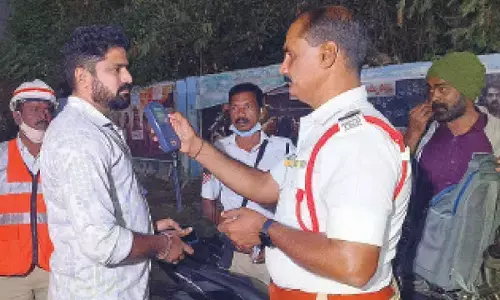Like coloured birds up in skies

Festival of kites
Pandemic hits kite makers, too, but they pin hopes on soaring spirits of people
Amid Covid-19 pandemic, as every festival is being celebrated as a low-key affair, the favourite festival sport amongst youth, the 'festival of kites' may also be subdued. Fearing this, kite-makers in the city have scaled down their production.
Dhoolpet in Old City is home to artisans (patang banana wale) known for making best kites. There are some 200 families dependent on this business – some in the trade for decades.
Madan Singh, owner of Sheetal Singh Patang Shaaz, says his family has involved in business for more than a century. He sees slump in sales, as much as by 60%, but pins hopes on soaring spirits of children and adults alike every year to raise the demand. They would not be cowed by Covid norms like social distancing and curbs on gatherings, feels Singh.
For kite makers, rise in raw material prices due to the pandemic scenario is another worry. Paper, stick and other material prices have almost doubled. Kites are likely to range from Rs 10 to Rs 30 depending on size and design. "For making kites, we have to purchase paper from Charminar and Osman Gunj and then we colour them. Later sticks will be pasted and thereafter a thread is pasted on all 4 sides of kite," he explains.
Overall, despite the enthusiasm of kite flyers, the craze for the sport is on wane year after year, due to the pull factor of ubiquitous electronic gadgets apart from TV and cinema, rue kite makers.
But, there are still diehard fans whose spirits rev up to soar along with their kites to skies. Such people give orders for design kites. "There are around 20 designs in kites which include, do lango topan, chand tara , Jibiya, toppan singade, toppan, aliban, gariyal and many more. These are most favourable among people for flying kites," says Madam Singh. The biggest kite and expensive among all are takhte ki patang and lowest price is choti ponki patang. "For flying kite in a smooth manner there should be a good quality paper, sticks and the design of the kite, this makes the kite to fly higher and takes elevation smoothly," he thus gives a tip.
Manja makers fight odds to keep going
The handmade desi manja is still prepared by families in the Old City. The times have changed but the traditional way of making the desi manja has not. It is an olden tradition of making manja sharp by boiled rice, glass dust powder and other materials.
A month or a two before Sankrathi festival, families in Dabeerpura gear up for making desi manja. "Earlier, we used to start manufacturing manja six months before the festival, but with Chinese manja taking up the major share of the market, the desi manja is surviving on the edge with diminishing orders. Extending, this year observing the pandemic the making of manja has been reduced," said Shaik Tayyab Amoodi.
"Earlier, people would come a few months in advance and ordered for manja. We used to manufacture thousands of meters of manja per day, but now it has reduced to half, and this year we have been affected more if the festival celebrated in low affairs," he adds. A thread is hung between two poles placed at a distance. Paste is applied and the thread is rolled. It is crucial to have right mixture of paste and exact pressure and time in manufacturing desi manja.
The material used for making the desi manja is boiled rice, soap, egg, glass dust powder and different colours etc. It takes around 30-45 minutes to prepare the paste.
There are two types of manja (Dheel and Kheench) for making dheel manja the width size of thread would be larger, and more amount of paste is applied, while for making kheench manja, normal size thread and normal amount of paste are used.
Desi manja and Chinese manja are of same price, but the Chinese manja is sharp and tough, giving advantage to the kite flyer during kite fights. But it also poses risk as it can damage fingers and cut others skin. Birds get entangled in them and die a painful death. There is a ban on them too. The desi manja costs around Rs 250 for 900 meters and Rs 750 for 1800 meters.
















